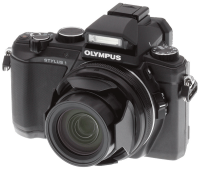Olympus Stylus 1 First Shots posted: How do images taken with this high-end, long-zoom camera stack up?
posted Monday, November 18, 2013 at 2:47 PM EDT

The high-end Olympus Stylus 1 marries the company's premium compact XZ-2 with the acclaimed mirrorless OM-D E-M5, so of course our interest was piqued when the bridge camera was announced just a few weeks ago. We've been eager to get the Stylus 1 into the lab and put it to the test; as such, we share our first batch of First Shots --- Still Life* target images taken at a full range of ISOs -- for your pixel peeping pleasure.
The Stylus 1 is feature packed, boasting an electronic viewfinder, hotshoe and advanced Wi-Fi capabilities, but most importantly it bears a new i.Zuiko 10.7x optical zoom lens with a constant f/2.8 maximum aperture. Though the camera follows in the footsteps of the Sony RX10 in providing an all-in-one, long-zoom geared for enthusiasts, the Olympus Stylus 1 arrives on the market far more compact, lightweight and inexpensive (US$700 vs. $US$1,300) than the Sony. The Stylus 1's sensor, however, is smaller -- a 12-megapixel, 1/1.7-inch-type backlist CMOS imager compared to the 1-inch-type sensor that's found in the Sony RX10. Meanwhile, the Stylus 1's TruePic VI processor is borrowed from the OM-D E-M5, and that should mean its imaging processing will be a cut above the XZ-2's.
So, how does the Olympus Stylus 1's images stack up against the Sony RX10, Olympus XZ-2 and even the E-M5? Place them side-by-side in our Comparometer™ to see for yourself! In fact, by using this tool, you can see how the Stylus 1 compares to any other camera we've ever tested.
See our Olympus Stylus 1 First Shots, or read our first impressions Olympus Stylus 1 review for more info about the long-zoom's new features and specs. Stay tuned for more test shots -- including our Multi Target and Far Shot images which will give you a better idea at how the camera performs wide open versus full telephoto -- as well as our complete camera review.
* Use our Still Life target images to look for detail (tone-on-tone, fine, highlights, shadows), as well as noise suppression, white balance, color accuracy and color shape retention.